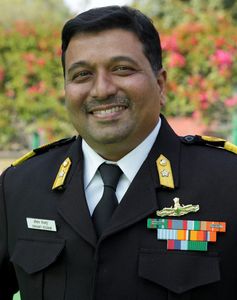AIRCRAFT CARRIERS ARE central to naval concept of operations. At the dawn of independence Indian Navy's founding fathers very perceptively prepared the blueprint for balanced fleets centred on aircraft carriers.
Aircraft carriers combine seapower with airpower to enable calibrated application of power in far seas and distant waters. In the Navy we often invoke the truism that influence is a function of both presence and persistence. Carrier Task Forces embody that principle most effectively.
We must not see power projection as a pejorative phrase. For one, it can be seen as a technical term denoting capabilities; the actual application always has political context. Second, a rising power like India will have regional and global interests and these need to be secured. No one can do that better than Carrier Task Forces.
It's not just India which is building aircraft carriers. If carriers were not needed, why do so many powers possess them or seek to have them?
Each arm of a nation’s military is important. Similarly, each component of the individual service. Therefore, we construct false binaries when we discuss carriers versus other platforms. For example, carriers versus submarines is apples versus oranges. Both have their strengths. Submarines’ greatest asset is stealth. Carriers, on the other hand, often need to advertise their presence. More relevant to this discussion, carriers can coerce or dissuade potential antagonists, during or before the war, in ways that submarines cannot.
Similarly, carriers versus island air bases, especially Andaman and Nicobar in our case, is a facile argument. First, the Navy has been in the forefront of development of security infrastructure on Andaman and Nicobar. Second, islands give some advantages of range but cannot move all over the world to distant regions where conflicts may take place. Third, if anything, it is even more easy to render the airbase of a stationary airfield inoperative.
It is a mistaken notion that aircraft carriers are sitting ducks in war. While making allowance for the fact that any ship may be targeted by the enemy, Carrier Task Forces have formidable combat power. Apart from the carrier’s own organic defence and self-protection systems, the powerful fleet ships in the Carrier Task Force provide solid support. It is not easy to penetrate this screen. In short, Carrier Task Force has enough defences to take care of itself. In the many conflicts since World War II, there is not enough conclusive evidence to say that aircraft carriers are sitting ducks.
It is also wrong to infer that new modes of warfare such as cyber or space are displacing the old. There are old and new warfares, and you need to be adept at all of them. Fleets and aircraft carriers will continue to be relevant even as navies upgrade and adapt to incorporate latest developments.
Frequently, the supposed high costs of aircraft carriers are given as arguments against them. This has to be seen in proper context. First, because our ships are indigenously built, the money goes to our own industry and manufacturing ecosystem generating employment in the MSME sector. Second, such endeavours give massive fillip to engineering and technology within the country. Third, the amount of combat potential and flexibility that an aircraft carrier offers is phenomenal.
Also read
- INS Vikrant docks at Karwar base, Navy calls it 'landmark'
- INS Vikrant proof of India's skill and talent: PM Modi
- PM Modi to commission home-made aircraft carrier Vikrant today
- How an aircraft carrier projects power deep into the coast
- The making of INS Vikrant
- Need three aircraft carriers: Vice Admiral M.A. Hampiholi
It is in this context that I feel India should possess at least four aircraft carriers. I don't think it is ambitious. The first step towards that should be to flag off the third carrier project at the earliest. The government should continue the momentum generated by Vikrant. Existing expertise must be harnessed and leveraged. If you start building a carrier again after 10 years, many who had worked on this project would have retired and we will lose that knowledge and talent. This has happened earlier with building submarines in India in the 1990s, and we must not make the same mistake again.
The commissioning of Vikrant is a new dawn for India and the Indian Navy. We must ride the crest of this high tide to build a stronger and more prosperous India.
Kesnur was until recently director, Maritime Warfare Centre in Mumbai, and officer-in-charge, Naval History Project.


